Tonga Travel Guide
Welcome to the taste2travel Tonga Travel Guide!
Date Visited: January 2018
Update
Following the eruption of the Hunga Tonga–Hunga Ha’apai volcano in December of 2021, some of the places mention in this report have been affected by the tsunami wave which inundated Tongatapu and the nearby islands.
In particular, Fafa Island resort has been completely destroyed!
Introduction
Malo e lelei! (Hello!)

Always a smile in the “Friendly Isles”.
Tonga claims to be the ‘True South Pacific‘ and with a history dating back more than 3,000 years and the Pacific’s version of Stonehenge, it rightly claims to be the ‘cradle of Polynesian culture’.

The elusive Maroon-shining parrot can be found on tiny Fafa Island Resort.
Tonga is a country where tradition and culture are still very much alive and practised. Tonga’s unique cultural values have been shaped by its centuries-old Monarchy – a Monarchy that puts God at the Helm. Tonga is the only country in the South Pacific which retains a monarch and is the only country in the region never to have been colonised.

A Fire dance performer at Hina Cave.
The Kingdom of Tonga once ruled over a vast area of the South Pacific and today the Tongans remain a proud race. This pride transcends everything and is most evident in their intense love and support for their famous Rugby team. Many businesses in Tonga proudly state that they are ‘100% Tongan Owned and Operated’.

Fragrant Frangipani’s are everywhere on Tongatapu.
While not a mainstream destination, Tonga received 59,000 arrivals in 2016. Of these, 40% were tourists, 44% were Tongans visiting friends and relatives and the remainder were business travellers.
Most arrivals into the country are members of the Tongan diaspora returning home from countries such as the United States, Australia and New Zealand to visit family.

A hand-printed ‘Lava-Lava’ (Sarong) in Nuku’alofa.
I enjoyed my time in the Kingdom and look forward to returning again one day to explore those stones I left un-turned – Vava’u and Ha’apai.
Location
Nuku'alofa, Tonga
Located immediately west of the International Date Line, The Kingdom of Tonga is one of the first countries in the world to see the sunrise each day.
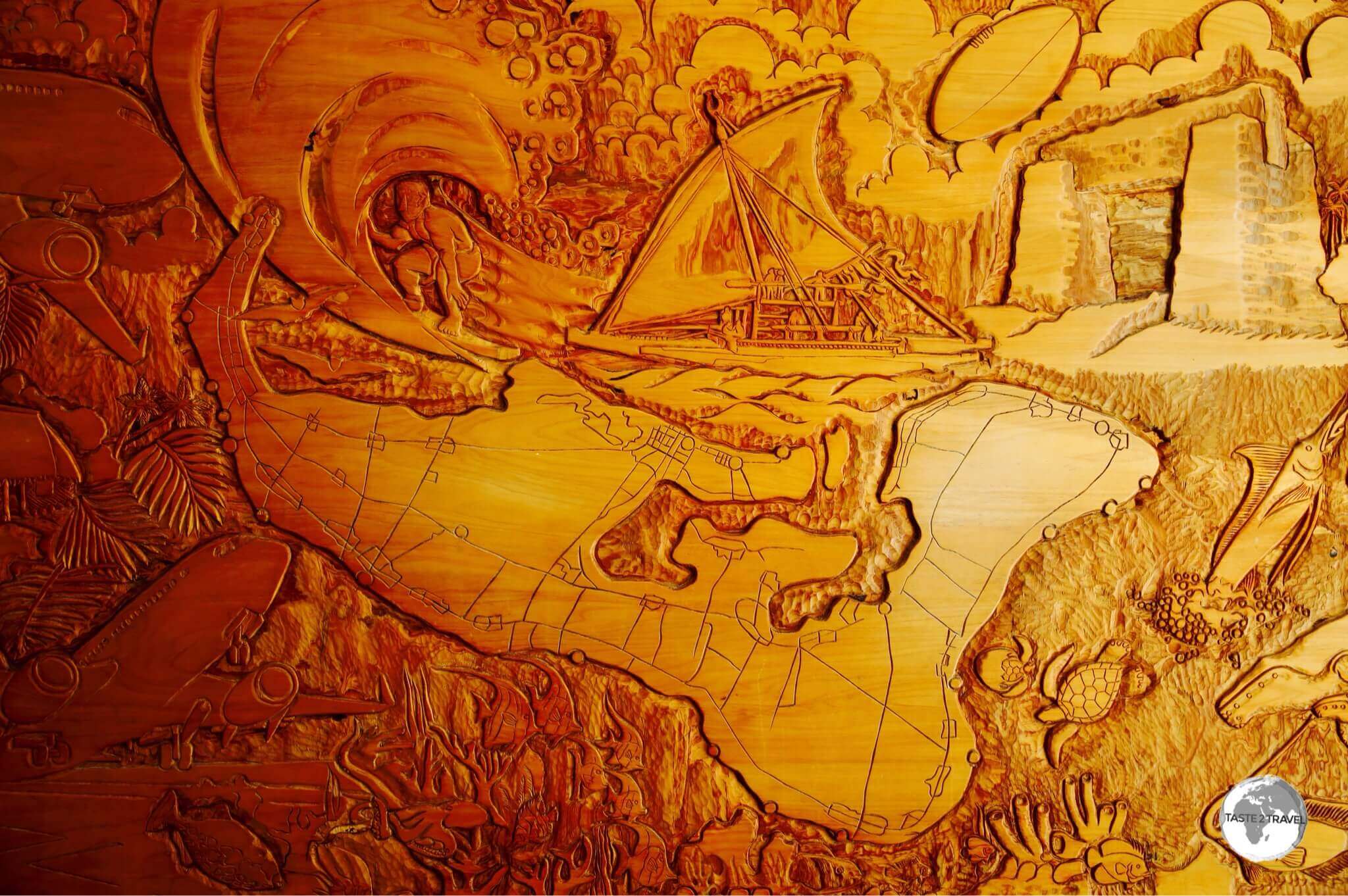
A wood-carved map of Nuku’alofa. Captain James Cook spent months here charting the archipelago.
An archipelago nation, Tonga consists of 170 islands divided into four island groups: Tongatapu in the south, Haʿapai in the centre, Vavaʿu in the north and remote Niuas in the far north. Tonga lies south of Samoa, east of Fiji and is about a third of the way between New Zealand and Hawaii.
People
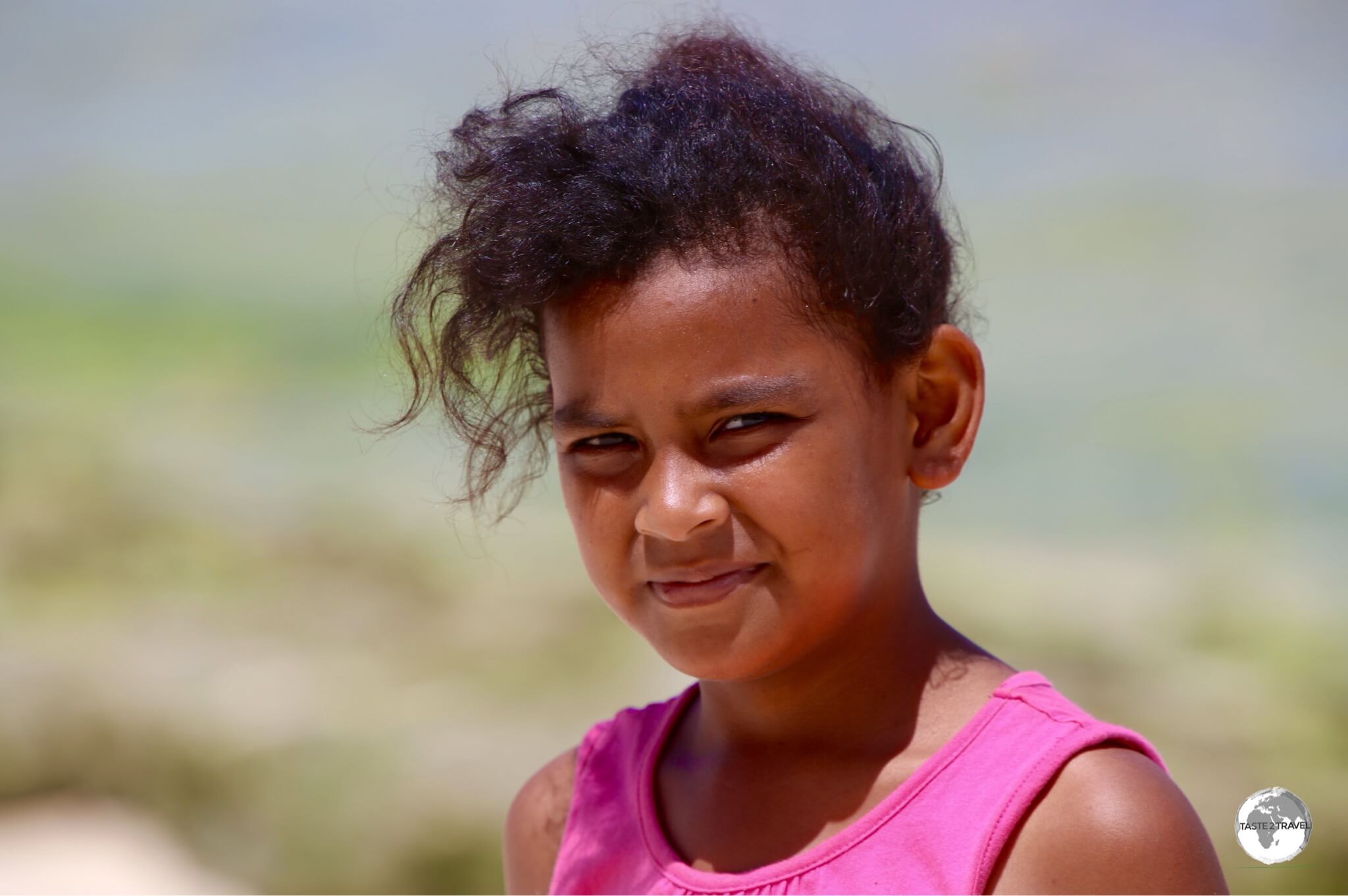
A young girl on Tongatapu Island.
Captain Cook dubbed Tonga “The Friendly Isles” and the real joy of travelling in Tonga is time spent with the warm and friendly locals.

A brother and sister playing on Tongatapu.
Tongans are generally relaxed, laid-back, gregarious and very friendly. You will normally be greeted with a smile and at no stage during my time there did I feel threatened, uncomfortable or unsafe. Spending time among the Tongan’s is a pleasure.
History
Polynesian History

The “Ha’amonga ‘a Maui” stands as an impressive monument to the ingenuity of the ancient Polynesians.
Tonga’s history begins more than 3000 years ago when the Lapita people from Southeast Asia migrated across the Pacific from Asia to (eventually) reach Easter Island – 5,000-km off the coast of South America.
In Tonga, these original ancestors of today’s Polynesian people, founded settlements and it was here that the Polynesian culture was created. Long before Europeans arrived on the islands, the Tongans were busy creating megalithic stonework’s, including the impressive “Ha’amonga a Maui” trilithon (see the ‘Sightseeing‘ section below) on Tongatapu.

A shy boy on Tongatapu.
Called the Stonehenge of the Pacific, it stands as an imposing legacy of early Tongan ingenuity. In the ancient capital of Muʻa nobles were buried in impressive “Langi” which are low, flat, terraced tombs made up of two or three tiers or coral blocks.
European Contact

An engraved portrait titled “Poulaho, King of the Friendly Islands”, which was made during Cook’s voyage, on display at Friend’s cafe in Nuku’alofa.
It was the Dutch who first sighted Tonga, when in 1616 the Dutch navigators Wilhelm Schouten and Jacob Le Maire discovered the Niuas Islands. In 1643, the Dutch returned when explorer Abel Tasman visited the Tongan Islands of ‘Atata, ‘Eua and Tongatapu. Today, a marker indicates Tasman’s landing spot on Tongatapu.
In 1773, the British explorer, Captain James Cook, visited Tonga’s southern islands of Tongatapu and ‘Eua. He returned in 1777 and spent two months exploring and charting the Tongan archipelago.
During this voyage, a lavish feast for Cook and his men was presented by Chief Finau in the village of Lifuka in the Ha’apai island group. Cook was so impressed by Tongan hospitality he dubbed Tonga ‘The Friendly Isles’, not realising the ‘friendliness’ of the locals actually concealed a plan to raid his boats and kill Cook and his crew.
The conspiracy was only foiled at the eleventh hour after a dispute between Finau and other village nobles, and Cook sailed away oblivious of his intended fate.

The residents of the “Friendly Isles” are very welcoming and friendly.
Between 1799 and 1852 Tonga went through a period of war and disorder. This was finally ended by Taufaʿahau, who was converted to Christianity in 1831 by the Methodist missionaries.
He became Tuʿi Kanokupolu and subsequently took the title King George Tupou I in 1845. During the king’s reign (1845–93), Tonga became a unified and independent country with a modern constitution (created in 1875).
Mutiny on the Bounty
Another navigator to visit Tongan waters was Captain William Bligh, commander of the HMS Bounty, who entered the history books while anchored off the island of Tofoa in the Ha’apai group.
On a quiet morning on the 28th of April, 1789 – Captain Bligh was abruptly woken at gunpoint by a young Fletcher Christian who ordered him and 18 loyal men, off of the 215-ton bounty and into a small 23-foot launch boat.
The pleading Bligh took his men to Tofoa and stayed there in a cave. At first the Tongans were friendly, welcoming them with coconuts and breadfruit. But then relations soured and in the end, Bligh and his men had to abandoned the safety of the cave and escape in their boat, embarking on a 6,500-km journey to East-Timor. Fletcher Christian and his men sailed east, eventually settling on Pitcairn Island.
Tonga Royalty

The current King of Tonga – Tupou VI.
Since at least the 10th century, Tonga has been ruled by a monarch. Around 950 AD, the Kingdom of Tonga underwent a period of expansion and eventually the ‘Tongan Empire‘ (Tuʻi Tonga) included the islands of Wallis and Futuna, Tokelau, Tuvalu, Nauru, parts of Fiji, the Marquesas islands, parts of the Solomon Islands, Kiribati, Niue, Cook Islands and parts of Samoa. The Empire declined in the 13th and 14th centuries due to ongoing wars and internal pressures.
The current royal linage started with King Tupou I who reigned from 4 December 1845 to 18 February 1893. He was eventually succeeded by his great-grandson King Tupou II, who died in 1918. During the reign of King Tupou II, Tonga became a British protectorate (in 1900) to discourage German advances.
Under the treaty with Great Britain, Tonga agreed to conduct all foreign affairs through a British consul, who had veto power over Tonga’s foreign policy and finances.
King Tupou II was followed by Queen Salote Tupou III, who ruled from 1918 to 1965. She was succeeded, upon her death, in 1965 by her son Prince Tupoutoʿa Tungi, who had been Tonga’s prime minister since 1949. He ruled as King Tupou IV.
In 1970 Tonga regained full control of domestic and foreign affairs and became a fully independent nation within the Commonwealth.
In September 2006, King Tupou IV died and was succeeded by Crown Prince Tupoutoʿa, who ruled as King Tupou V. A month after he came to power, the King was faced with pro-democracy protests, which turned into a riot that went on for several weeks. Arson destroyed most of the capital’s business district and left seven people dead; hundreds were arrested. Troops were called in from New Zealand and Australia to re-establish peace.
Following his accession to the throne, King George Tupou V began divesting himself of ownership in many of the state assets that constituted much of the wealth of the monarchy. King George Tupou V died in Hong Kong on March 18, 2012.
He was succeeded by his brother, Crown Prince Tupoutoʿa Lavaka, who currently rules as King Tupou VI.
Christianity in Tonga

Worshippers in traditional dress leaving a church service on ‘Eua.
The arrival of European explorers and navigators from the 17th century saw the introduction of Christianity, now an integral part of modern-day Tongan life. Earlier attempts to introduce Christianity into the Kingdom failed – but in 1826, a Methodist mission was successful, and a Roman Catholic mission was established in 1842.
The most important convert to Christianity was King Tupou I. Once the King converted, the nation converted. Today, Tongans regularly attend church, with services running on Sundays and at other times during the week.
It is customary to dress in traditional dress and services feature lots of beautiful, enthusiastic gospel singing. Attending a service is something to experience while in the Kingdom.

A young girl on ‘Eua Island, on her way to church.
As for Sunday – Tongans take their Sabbath seriously with absolutely everything closed (as mandated by the law). The popular thing for tourists to do on this otherwise quiet day is to plan a day-trip to one of the resort islands close to Nuku’alofa (see the ‘Sightseeing’ section below).
Because of their religious beliefs, Tongans are very modest in every aspect of their lives, especially their dress, and as such always swim fully clothed. Bikinis are only worn by tourists and should never be worn away from the beach.

A cross among the palm trees on Pangaimotu Island.
Cemeteries

Dedicated to ‘Popi’, this huge gravestone banner is comprised of many small, hand-crochet squares.
Tongan cemeteries are colour affairs, with families taking great pride in decorating and maintaining the grave-sites of departed loved ones. Graves are often decorated with elaborate, handmade blankets, beer bottles, colourful banners, photos, Christmas trees, flowers and anything else.

Grave site on ‘Eua island.
At night the graves are often lit with flashing lights and on weekends families come to BBQ/ picnic next to their departed kin.
Flag

The flag of Tonga.
The flag of Tonga consists of a red field with a white canton charged with a red ‘couped cross‘. Adopted in 1875 after being officially enshrined into the nation’s constitution, it has been the flag of the Kingdom of Tonga since that year. The constitution stipulates that the national flag can never be changed.

The Tongan flag flying in Nuku’alofa.
The colours of the flag have religious meaning with the red cross alluding to Christianity while the white represents purity and the red background evokes the sacrifice of the Blood of Christ.
Currency

All bank notes in Tonga feature King Tupou VI.
The national currency of Tonga is the Pa’anga, or Tongan dollar (TOP). The exchange rate as of January 2018 was: USD$1.00 = TOP$2.00
There are two commercial banks in Tonga which provide ATM’s :
- The Fiji owned – Bank of the South Pacific (BSP), provides ATM’s throughout the country, including on Tongatapu (Nuku’alofa) and ‘Eua (‘Ohonua).
- The Australian owned – ANZ, provides numerous ATM’s on Tongatapu and one on Vava’u.
Philately

Tongan stamps are works of art and make for interesting souvenirs.
Stamps are available from the small Tonga Post Office counter in downtown Nuku’alofa. The post office is open 6 days a week (half day on Saturday), with philatelic items stored in a locked room next door.

Tongan stamps are available for purchase from the Nuku’alofa Post Office.
Arts & Crafts
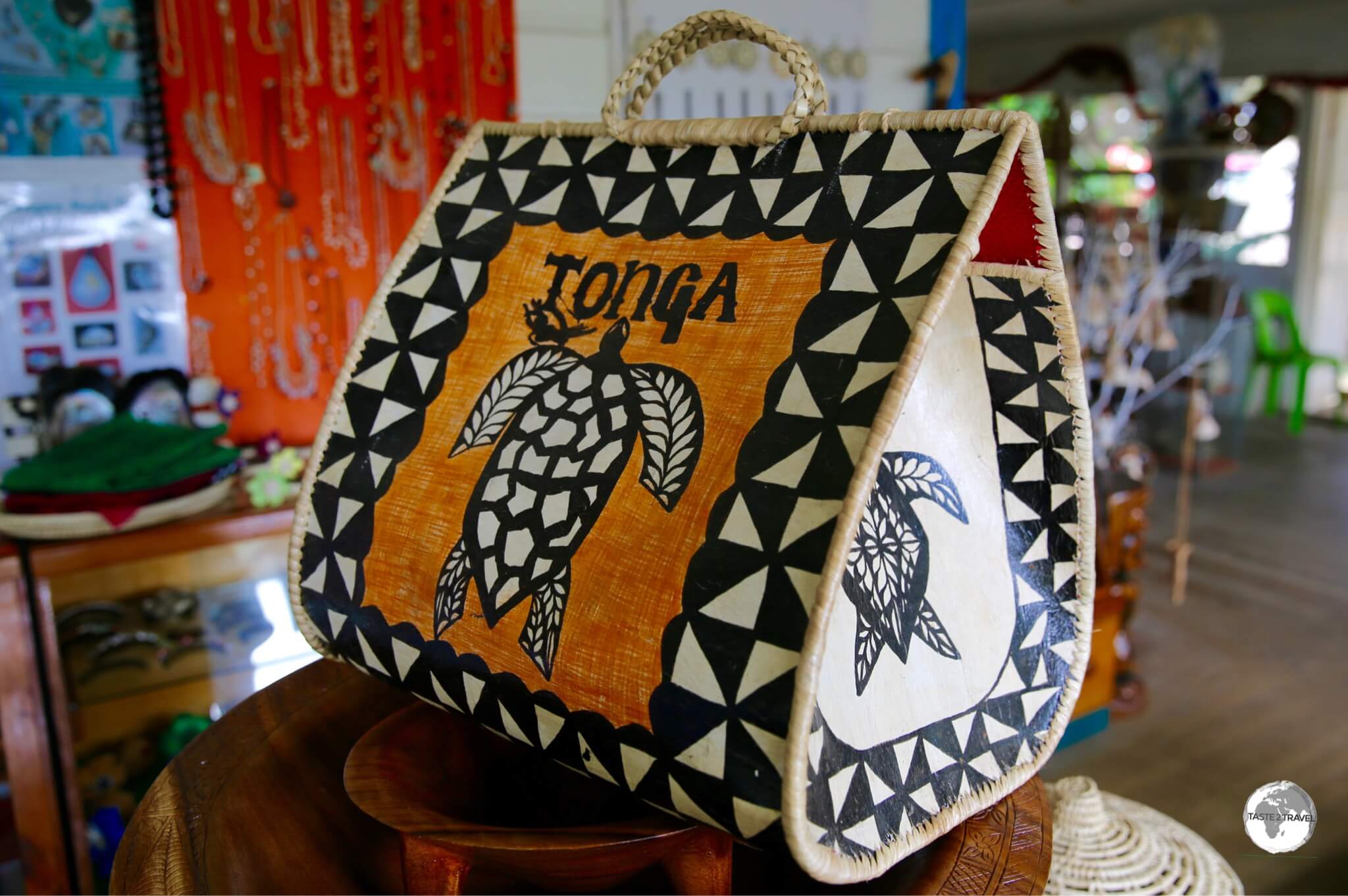
Tonga is famous for it’s woven handicrafts.
Tonga has a rich tradition of arts and crafts, from delicate bone carvings, tapa-cloth products, woven baskets and mats, wood carvings and paintings.

Salote – the helpful attendant at Langafonua women’s co-operative in Nuku’alofa
A good place to shop for quality products (at fixed prices) is Langafonua, a women’s co-operative in downtown Nuku’alofa – next to Friend’s Café.
While you are sipping your coffee in Friend’s café, be sure to check out the beautiful Tongan paintings which adorn the walls.

A traditional straw skirt on sale at Talamahu market in Nuku’alofa.
The downtown Talamahu market is also good for picking up a bargain but prices are not fixed so a little bargaining is required.
Tapa Cloth

Handmade Tapa cloth souvenirs, such as these ones at Talamahu market, make for ideal gifts.
Made from the bark of the mulberry tree, known locally as Hiapo, tapa cloth is of great cultural significance in the Kingdom of Tonga. The giving of decorated Tapa cloth is an important custom in Tonga and the best postcards are made from tapa.

Hand-painted Tapa fans are popular souvenirs.
Traditional Mats
Mat weaving is also a part of Tongan life and most households hold beautifully designed mats as treasured possessions. Mats are traditionally presented at births, marriages and funerals.
The Ta’ovala

The woven Ta’ovala is worn around the waist for all formal occasions in Tonga.
One of the striking things in Tonga is how many people wear the distinct national dress. It’s a smart look – with men wearing an ankle-length ‘lava-lava’ (a wrap-around skirt), which is topped with a short-sleeved shirt, and then (if it’s formal wear) they tie a ta’ovala (made from woven pandanus leaves) around their waist which is then held into place by a woven leather belt-like device.
Woman also wear the ta’ovala. This tradition is said to have originated in ancient times when returning fisherman would cut lengths off their sail and cover their naked bodies before presenting themselves to their chief.
Sightseeing

Friend’s Cafe is the perfect place to plan your exploration of Tongatapu.
Tongatapu
Nuku’alofa
Royal Palace

The official residence of the King of Tonga, the Victorian-style, wooden Royal Palace overlooks the waterfront in Nuku’alofa.
The capital of Tonga is sleepy Nuku’alofa (population: 30,000) which is located on the north coast of the largest island – Tongatapu. Nuku’alofa is a functional administrative centre but with few tourist attractions except for the Royal Palace and the bustling Talamahu central market.
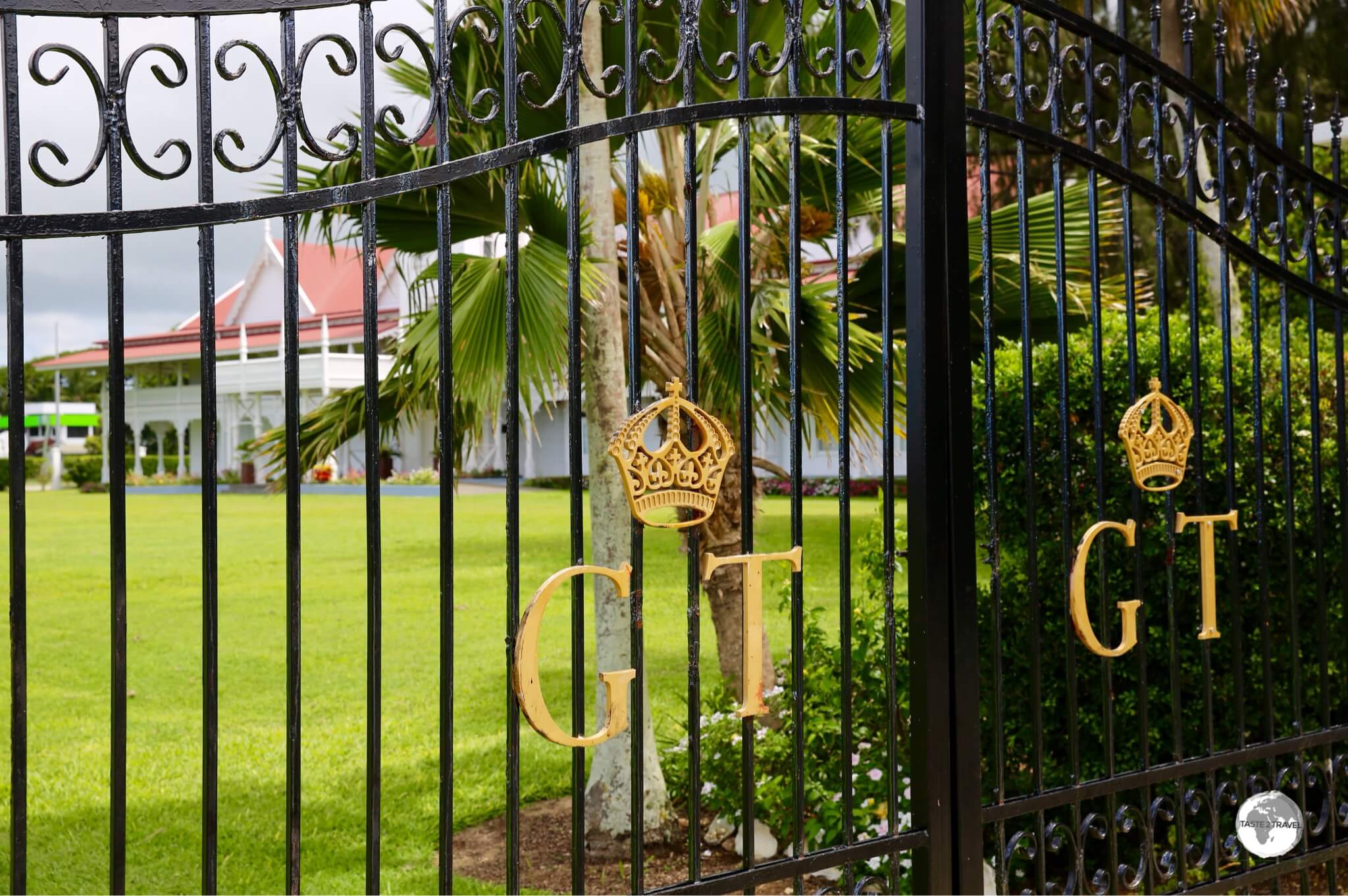
The best view of the Royal palace is through the Palace gates.
The Royal Palace of the Kingdom of Tonga is located on the waterfront in Nuku’alofa. The wooden Palace, which was built in 1867, is the official residence of the King of Tonga.
Although the Palace is not open to the public, it is easily visible from the waterfront or either of the side streets, with the best view being through the Palace gates on the western side of the property.
Talamahu Market

Souvenir Tapa fans on sale at Talamahu market in Nuku’alofa.
Located in the centre of town, the lively, bustling (particularly on Saturday mornings) Talamahu market is the place to come to see Tongans buying their fresh-produce, which is normally sold in baskets woven from palm fronds.

The daughter of a vendor at Talamahu market.
The market is also a great place to find outstanding Tongan arts and crafts, with lots of stalls selling souvenir t-shirts, tapa cloth, bone carvings, wooden bowls, fans, mats etc.

Tapa souvenirs at Talamahu market in Nuku’alofa.
Outside Nuku’alofa
Captain Cook’s Landing Place

A marker near Holonga village indicates Captain James Cook’s landing place on his 3rd visit to Tonga.
A simple marker above a mangrove inlet near Holonga village indicates the place where Captain James Cook landed on Tongatapu in 1777 during his third visit to Tonga.
Cook first Tonga visited in 1773 (stopping at Tongatapu and ‘Eua), then in 1774 (stopping at Nomuka in the Ha’apai Islands) then in 1777 where he landed at this spot. On his third visit he spent several months mapping the coastline and documenting pre-Christian life in the islands.
Muʻa

Ancient stepped tombs (‘Langi’) in Mu’a.
A short drive up the road from Captain Cook’s Landing Place is the small town of Muʻa, which was for many centuries the capital of ancient Tonga.
Today what remains are the impressive ancient ‘Langi‘ (royal burial tombs), which are clearly visible from the road. When a Tongan King died he was buried in one of the tiered burial mounds, the walls of which are constructed from huge slabs of coral stone.
Haʻamonga ʻa Maui

The #1 sight in Tonga – the impressive “Haʻamonga ʻa Maui” (the Stonehenge of the Pacific).
One of the most popular sights to visit in Tonga is the 5-metre high, Haʻamonga ʻa Maui (Burden of Maui), which is known as the Stonehenge of the Pacific.
Located on the north of Tongatapu, this stone trilithon is made of three huge coral limestone blocks that weigh more than 40 tons each. Hand-hewn mortises in the top of each upright stone, allow the large lintel to slot into place. It is believed the structure was built during the 13th century and possible served as a gateway to a royal Palace.
A short walk towards the coast brings you to the ‘esi maka faakinanga’ (stone to lean against), which served as the king’s throne. Sitting with his back to that stone, he was safe from assassins from behind, and with his long stick he could hit every potential foe from the front on his knees.
Legend also states that the structure was created by the god Maui, as the stones would be too huge for mortals to handle
‘Anahulu Cave

‘Anahulu Cave features soaring limestone caverns and lots of bats and swiflets.
Located on the eastern side of Tongatapu, the ‘Anahulu Cave is made up of a network of large limestone caverns, as well as Tongatapu’s only freshwater pools. The cool, subterranean pools are especially popular with local bathers who come to cool off from the blistering tropical heat.

Locals bathing in the deep freshwater pool inside ‘Anahulu Cave.
The caverns are home to nesting swiftlet’s and bats and are lined with impressive, glittering stalactites and stalagmites. There’s an attendant in the car park who collects a TOP $15 entrance fee.
Hina Cave

Fire dancing is a highlight of the floor-show at Hina cave.
Down the road from ‘Anahulu Cave, and part of the ‘Oholei Beach Resort, Hina Cave is only open on Wednesday and Friday evenings as part of the Tongan Feast Buffet & Floor-show.
According to a popular legend, the cave gets its name from the fact that a beautiful maiden called Hina, who lived in the area, waited in the cave for her love to return from a day of fishing. He never returned and she died of a broken heart inside the cave.

Fire dancing at Hina Cave.
Tickets to the show cost TOP$40 (or TOP$55 including return transport from Nuku’alofa) and include an excellent Tongan buffet, music and the floor-show inside the cave. Although many tourists attend, there are plenty of Tongans in attendance so it doesn’t feel too touristy.
Blow Holes – Mapu’a Vaea

“Mapu’a Vaea” are a series of blow holes located on the south coast of Tongatapu Island.
Mapu a Vaea or “Whistle of the Noble” are natural blowholes located on the south coast of Tongatapu near the village of Houma.
The blow holes are the result of water being forced into a natural channel in the reef which is then forced up into the air through holes in the limestone. As the water passes through the holes, it creates a soft, whistling sound hence the name.

A young boy ready for a swim on the south coast of Tongatapu.
Tsunami Rock
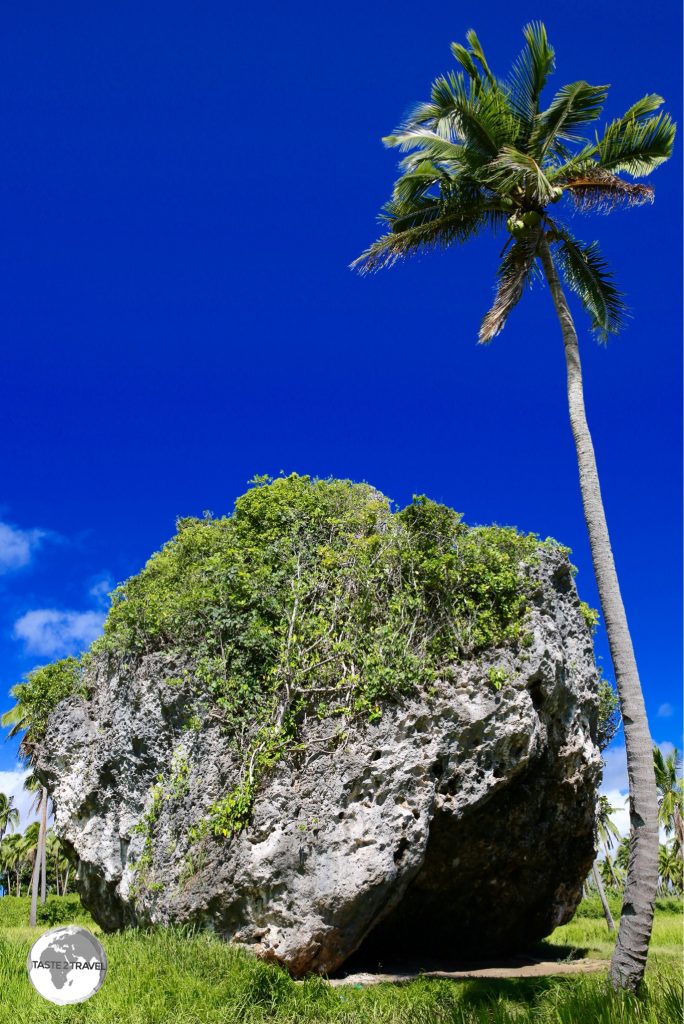
Tsunami Rock is an impressive boulder located in the middle of a field.
West of the blow holes and slightly inland from the coast (on a dirt track) lies the imposing Tsunami rock – a 1,600-ton boulder which was apparently ripped from the adjacent reef by a powerful tsunami a few thousand years ago.
The west coast of Tongatapu is the place to come if you are looking for sandy beaches and it’s here you’ll find a few local beach-side resorts.
Abel Tasman Landing Place

A marker indicates Abel Tasman’s Landing Place on Tongatapu Island.
At the most north-western tip of Tongatapu, you’ll find Abel Tasman’s Landing Place. Like Cook’s landing place, a simple marker indicates the landing spot, where Tasman came ashore on the 21st of January 1643 (130 years prior to Cook’s first visit).
At the time, the Dutch navigator was on his way back to Batavia (present-day Jakarta) in the Dutch East-Indies after firstly bumping into Tasmania, then New Zealand.
Tasman and his men traded nails, cloth and other things in exchange for water, pork and coconuts. Tasman named Tongatapu ‘Amsterdam’ then left.

Swimming in the harbour at Nuku’alofa.
Resort Islands
Pangaimotu Island

The wreck at Pangaimotu Island provides and ideal snorkeling spot.
Pangaimotu Island resort is busiest on Sunday’s when everything on the mainland is closed. At the heart of the resort is the relaxed, beach-side Mama’s Restaurant & Bar.
The cost of a day-trip to the island is TOP$50 (payable on the island), which includes return boat transfers, lunch at Mama’s and snorkelling equipment. The equipment I was given looked like relics from the pearl-diving era and was totally dysfunctional – best to bring your own.

The view from the deck at Mama’s bar on Pangaimotu Island.
Located 50 metres off the main beach is a half-submerged wreck which you can jump off or snorkel around. The island is small enough that you can walk around it in 20 minutes (best at low tide) and includes a mangrove area full of seabirds.
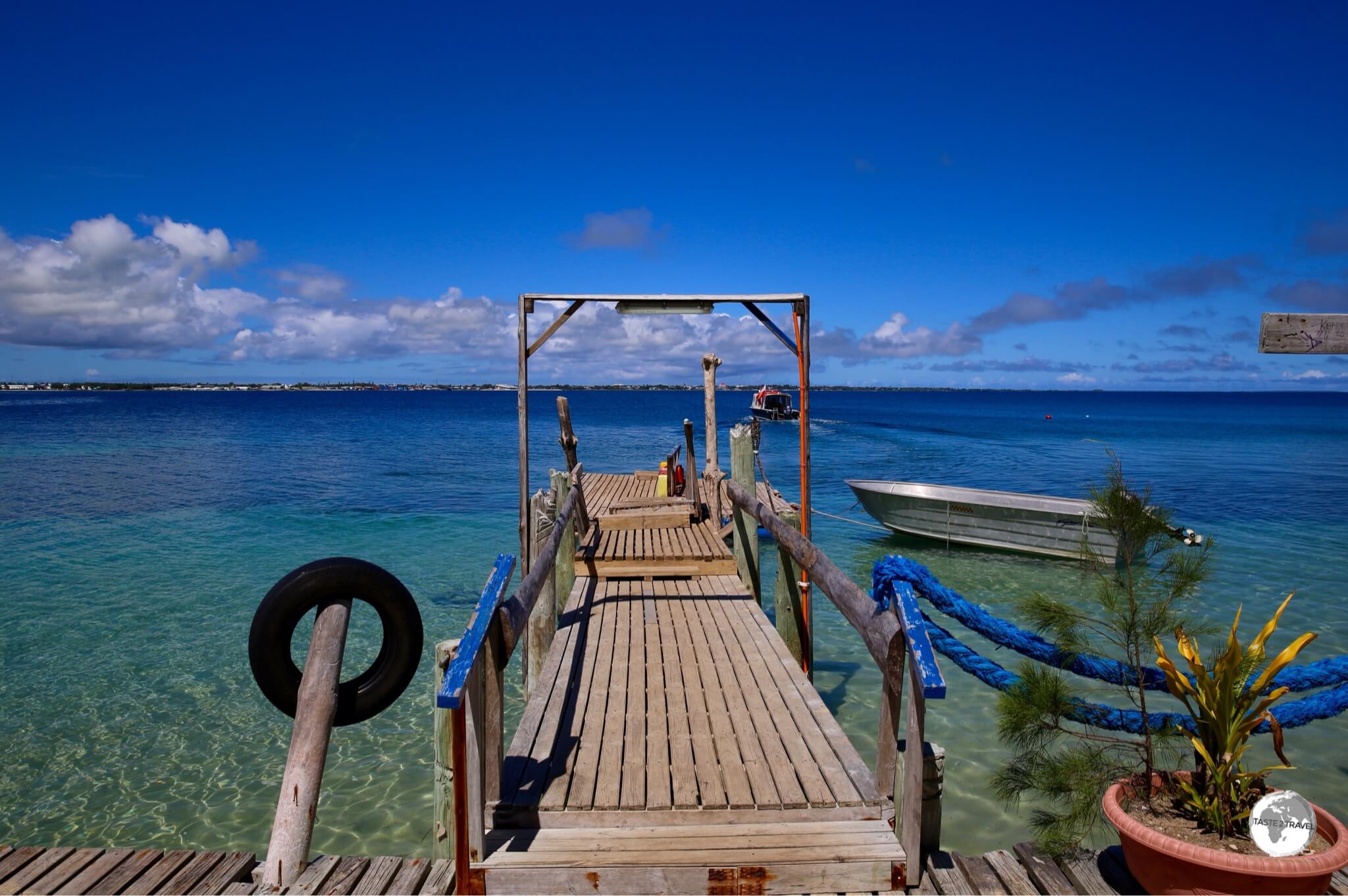
Mama’s Bar and Restaurant at Pangaimotu Island.
Getting There: A small passenger ferry makes the 10-minute crossing to the island from Nukualofa’s Resort ferry wharf (opposite the Waterfront Inn), departing (Monday – Saturday) at 11:00 am, returning at 4:00 pm.
On Sunday’s, ferries depart at 10:00 am, 11:00 am, 12:00 pm & 1:00 pm, returning at 4:00 pm, 5:00 pm and 6:00 pm.
‘Atata Island

The inviting beach at the Royal Sunset Island resort on ‘Atata Island.
Located on the southern tip of ‘Atata Island is the old and tired Royal Sunset Island Resort.

Christmas tree at the Royal Sunset Island resort on ‘Atata Island.
Day-trips to the resort from Nuku’alofa are popular with one boat departing at 11:00 am each day from the ‘Resort Ferry Wharf’ (opposite the Waterfront Inn) and returning at 4:00 pm.
The cost for the day trip is TOP$70, which includes return boat transfer, lunch at the resort and a snorkelling trip.

A typical ‘Fale’ at the Royal Sunset Island Resort on ‘Atata.
The resort is in need of complete renovation and service is hit and miss but the lunch of grilled local fish was very nice.

Friendly children in the village on ‘Atata Island.
Unlike other islands, there is a small village on ‘Atata which you can walk to (10 mins) from the resort. As with other villages in Tonga, the local inhabitants are friendly and welcoming.

Fishing boat in the village on ‘Atata island.
Fafa Island

A true tropical paradise – Fafa Island Resort.
Of all the resort islands I visited, Fafa island resort was my favourite. From the moment you arrive, the friendly staff are on the beach to greet you, leading you to the restaurant area where you can enjoy a relaxing drink or an excellent coffee.

The Fales at Fafa Island resort are set on secluded sites around the island, maximising privacy for their guests.
The resort is the creation of a German who has built a little piece of heaven in the South Pacific. The service, facilities, food and environment are all perfect and it’s a favoured destination for Honeymooners.
The waters around the island are teeming with marine life so snorkelling is excellent as is the equipment provided by the resort. In between activities you can relax in the cosy library where you’ll find excellent Wi-Fi.
The deluxe Fales at Fafa Island resort are set in secluded locations around the island, maximising privacy for their guests.

Interior view of a Fale at Fafa Island resort.
Source: Fafa Island Resort
If you’re a keen bird photographer, you’ll be happy to known Fafa is home to at least eight (rare) Maroon-shining parrots which can be found hiding out in the trees.

The rare Maroon-shining parrot (Red-shining parrot) on Fafa Island.
The parrots are native to Fiji but were often traded for their feathers throughout the Pacific. A small population has lived on ‘Eua for centuries and the birds on Fafa Island are descendant from a single breeding pair that was introduced to the island.
Getting There: A once-daily sailboat makes the journey out to Fafa island, departing from the ‘Resort ferry wharf’ opposite the Waterfront Inn in Nuku’alofa at 11:00 am, returning at 4:00 pm.
The cost for the day-trip is TOP$92 which includes transport, an amazing lunch at the resort restaurant and snorkeling equipment.
The only problem with my day-trip was that there was not enough time to do everything I wanted to do. Best to stay longer!
‘Eua Island

A towering tree fern deep in the rainforest on ‘Eua island.
It’s a wonder that Hollywood producers have yet to discover incredible ‘Eua (pronounced e-wah). The sights that remain hidden away in the depth of the rainforest are spectacular and can be visited in half a day, although signage is poor so it’s best to explore the island with a local guide.

A mother and son attending church on ‘Eua Island.
‘Eua is the least developed island in Tonga and offers none of the ‘big-city’ attractions you’ll find in Nuku’alofa. There are no restaurants, cafes or bars and most things close very early. ‘Eua is ideal for those seeking incredible nature and exposure to a very traditional way of life.

I scream ice-cream! A young girl enjoying an ice cream on ‘Eua Island.
You can reach ‘Eua from Tongatapu via the World’s shortest commercial flight (7 minutes) or ferry – see the ‘Getting Around’ section for more details on both.

The ‘Eua Island courthouse in Ohonua village.
The main settlement on ‘Eua is ‘Ohonua, which is where the ferry docks. The Bank of South Pacific (BSP) have an ATM at their branch on the main street.

A house with a well-tendered garden on ‘Eua island.
I visited the following sites on a half day island tour organised through the Ovava Tree Lodge (see the ‘Accommodation’ section for more details on Ovava).
Ovava

A hiker provides scale for the huge Ovava (Giant Strangling Fig) tree on ‘Eua Island.
Hidden away in the middle of the rainforest is an incredible Giant Strangling Fig (Ovava) tree.
‘Ana ‘Ahu

‘Ana ‘Ahu, a bottomless sink-hole in the middle of the rainforest on ‘Eua Island.
Breath-taking, mind-blowing and scary all at the same time! ‘Ana ‘Ahu (smoking cave) is a dramatic sink hole located in the middle of the rainforest which has a small waterfall trickling into it’s depths.
The water falling into the hole releases a mist which looks like smoke in the sunlight, hence the name. Our guide demonstrated the ‘bottomless pit’ aspect of the hole by throwing in a stone, which could be heard bouncing off the walls until it could no longer be heard.
Wild Horses

One of the many wild horses on ‘Eua Island.
On the southern tip of the island are a pack of semi-wild horses, which roam freely over the grassy slopes at the top of the dramatic cliffs which plunge into the ocean far below.
Rock Garden

A Brown Booby soaring on the breeze at the Rock garden on ‘Eua Island.
High on the cliffs of the south coast is a natural limestone rock garden. If you look over the cliffs you’ll find nesting seabirds, such as the Brown Booby, which can be seen soaring offshore on the strong ocean breeze.
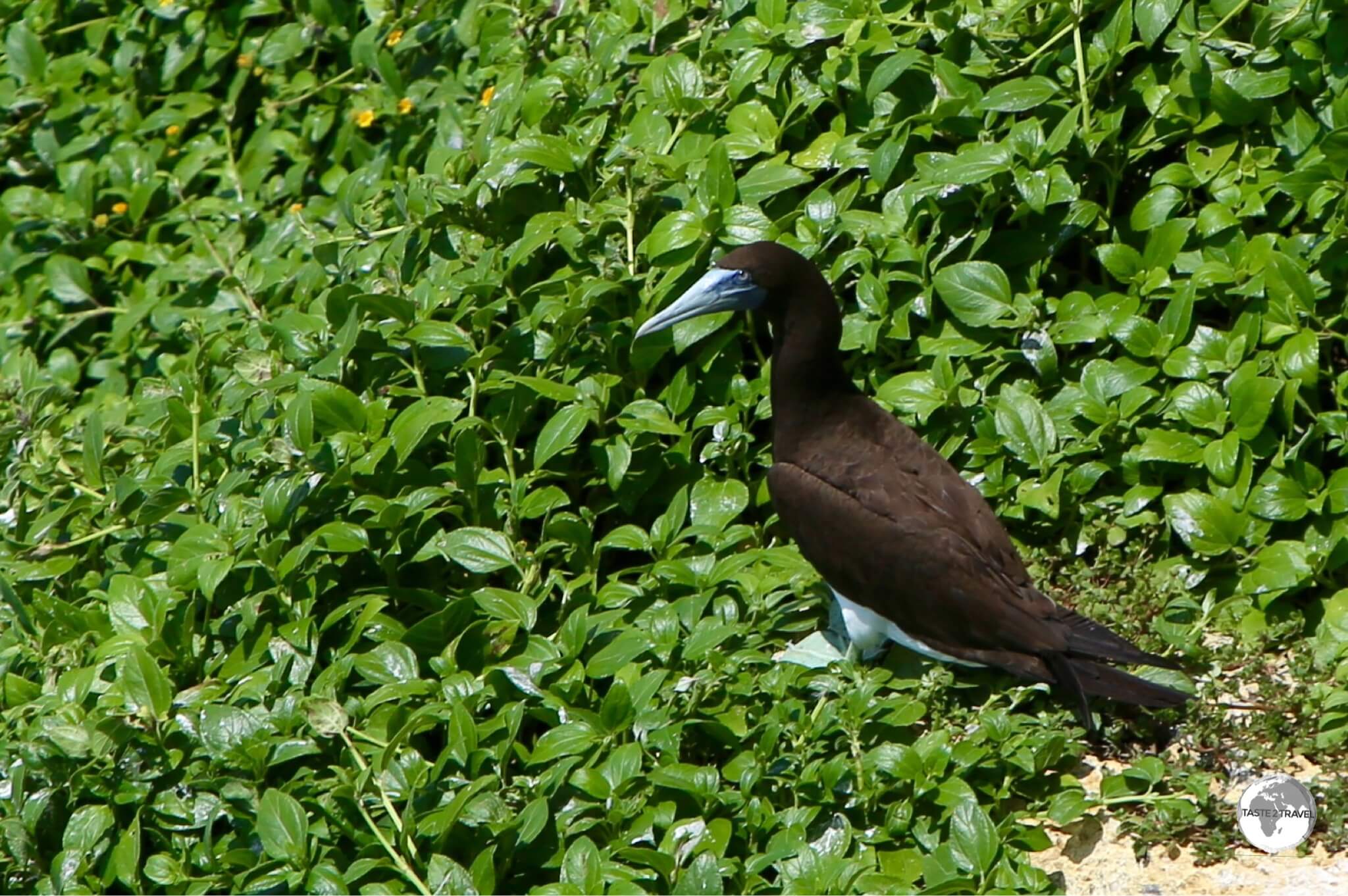
A Brown Booby nesting at the Rock Garden on ‘Eua Island.
Natural Archway

The impressive Natural Archway on the south coast of ‘Eua Island.
Legend has it that the god Maui was responsible for creating this dramatic archway when he threw his spear from the centre of the island and it landed at this spot on the coast. When he pulled his spear out of the ground, it left a gaping hole – the archway.

The south coast of ‘Eua is lined with precipitous cliffs.
Accommodation
Tongatapu Island

My very comfortable room at the Waterfront Inn in Nuku’alofa.
There are no international branded hotels or 5-star resorts in Tonga, with almost all properties being small locally owned and operated. The stand-out resort which I visited while on Tonga is the wonderful resort on Fafa Island – refer to the ‘Sightseeing – Resort Islands‘ section for more details.
In Nuku’alofa, I stayed at the charming and well-run Waterfront Inn which is conveniently located opposite the Resort ferry wharf (and a taxi stand). Rooms are arranged on the upper level of a beautiful 2-story colonial-style home, which is surrounded by lush gardens with views onto the harbour. The restaurant here (see the ‘Eating Out’ section below) is one of the best in town so it’s an ideal place to base yourself. Best to book rooms on Booking.com.
Also on the waterfront is the recently renovated, 120-room Tanoa International Dateline Hotel. The hotel looks like it’s been dropped into Tonga from Florida with modern rooms arranged in three (3-story) wings which enclose a large, open, central, courtyard that has a swimming pool (not easy to find in Tonga) at its centre. The poolside restaurant is a popular place anytime of the day – including Sunday.
If you must overnight near the airport (35-km from Nuku’alofa), the best (and only) option is the (New Zealand owned and operated) Scenic Hotel. Set in the middle of the countryside, on the main road in front of the airport, the Scenic offers comfortable rooms, a restaurant serving tasty local cuisine, a swimming pool and extensive gardens.
If you’re backpacking there are a few options in Nuku’alofa, with possibly the best being the cosy Hafu’s House Backpackers, (you can read the reviews from their many satisfied guests on their Facebook page), which is owned by husband and wife team Will and Kate.
Other backpacker options include The Village Backpackers which is located downtown on the main street and the nearby Backpackers Townhouse.
‘Eua Island

Ovava Tree Lodge features wooden ‘Fales’ in a lush garden setting.
I stayed at the ‘Ovava Tree Lodge (Tel: +676 – 50882) which is conveniently located opposite the ferry wharf. I didn’t enjoy my stay here and would not recommend the place – you can read my full review on TripAdvisor.

My room at Ovava Tree Lodge on ‘Eua Island.
Apart from ‘Ovava Tree Lodge, there are just two other accommodation options on the island:
- ‘Eua Hideaway (As of June 2018, the Hideaway is closed long-term for renovations following damage from cyclone Gita).
- Taina’s Place – (Tel: +676 – 50186) – Taina’s Place consists of fibro cabins set among well tendered gardens in the interior of the island.
Eating Out
Café
Friend’s Café

The best cafe in Tonga, Friend’s cafe in Nuku’alofa.
Just as there are no international chain hotels or resorts in Tonga, so too there are (refreshingly) no international fast-food/ restaurant chains. Not surprisingly, seafood and local vegetables and fruits are the main feature on menus but you’ll also find local pork and chicken.
For a small town, Nuku’alofa offers a good range of restaurants, cafes and bars.

My favourite café in Tonga, Friend’s Café, where roaming roosters clean up stray crumbs.
Of the cafés, the best in Tonga is Friend’s Café. This is a local institution and it’s easy to see why. The café offers the best coffee in Tonga, great tasting meals, cakes, Wi-Fi, music and so much more.
The walls of the café are lined with Tongan artworks and museum-worthy displays. The atmosphere is very homey and cosy and I have to confess to visiting more than once a day.
Life would be so much more pleasant if every town on earth had a place like Friend’s café.
Open daily from 7:00 am to 10:00 pm (except Sunday).

Local musicians performing at Friend’s Café.
One song which I heard often while sipping my latte at Friend’s café was Kingdom of Tonga by Angela Afeaki:
Diagonally opposite Friend’s café is the Coffee Post where friendly staff also serve very good espresso coffee, all day breakfast items and fine cakes. Unfortunately, there’s no Wi-Fi available.
Café Escape

A very tasty Swordfish steak for lunch at Escape café.
Further along the main road, Café Escape offers Wi-Fi, good coffee plus wonder lunches including local grilled fish served with mash potatoes and salad.
Restaurants
Fafa Island Resort

The perfect setting for lunch at Fafa Island resort.
If you make it out to Fafa Island resort, there’s an espresso machine and wonderful, professional staff who’ll prepare the best café latte you’ll find on any remote Pacific isle.
The homemade desserts are worth the trip alone and are included in your lunch/ transport ticket.

My lunch at Fafa Island resort, amazingly fresh local Snapper with a curry sauce.
Waterfront Inn
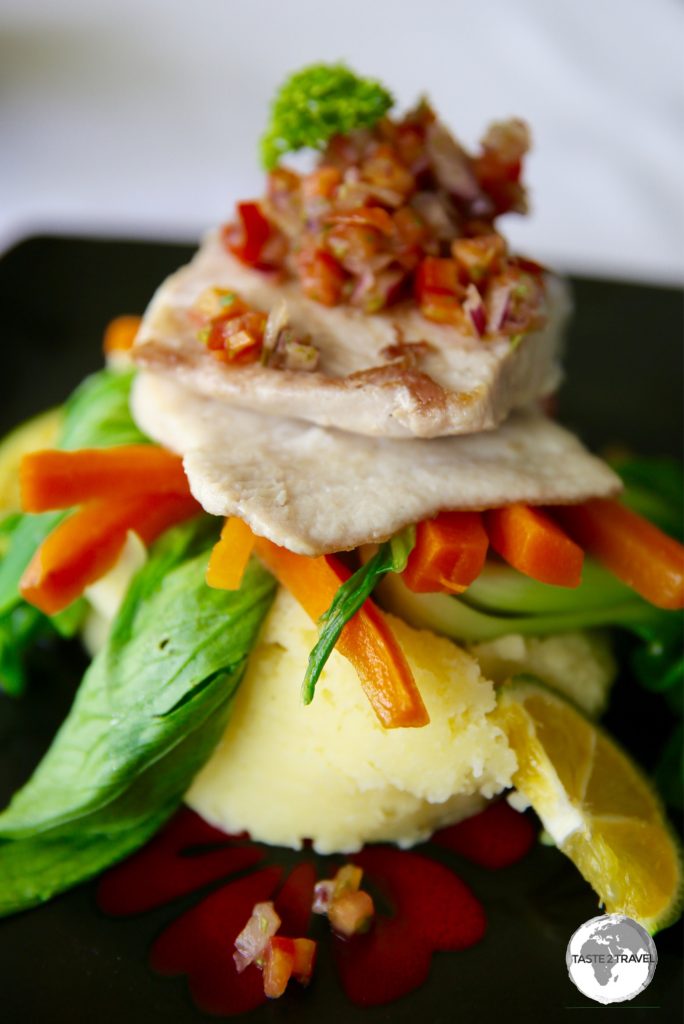
Grilled local Snapper, always divine at the Waterfront Inn in Nuku’alofa.
The Waterfront Inn serves exquisite meals in an atmosphere full of refined, old-world charm. One evening, the government booked the entire restaurant for a function – it is the place for fine dining in Nuku’alofa.
I can especially recommend any of their grilled fresh local fish which is always served on a bed of fresh vegetables and the creamiest mash potato.
After dinner it’s hard to pass up sampling one of their impressive desserts. My favourite was the heavenly, freshly baked, chocolate lava cake, served with vanilla ice-cream.
Tanoa International Dateline Hotel
When everything else in Tonga is closed on a Sunday, the one restaurant serving meals is the poolside restaurant at the Tanoa International Dateline Hotel. The menu includes fish ‘n’ chips, hamburgers and other international favourites.
Bars
The best bar in Nuku’alofa is Billfish, which is located on the waterfront beyond the Waterfront Inn (both are owned by the same owners).
Billfish is open every day (except Sunday of course) and features a wonderful, lively atmosphere, amazing staff, a tuneful DJ, dart’s and lots of happy regulars. This is a great place to meet the locals and ex-pats.
Tongan Beer Tasting
- Beer # 1 of my Billfish tasting – Mata Maka.
- Beer # 2 of my Billfish tasting – Maui.
- Beer # 3 of my Billfish tasting – Tikii.
- Beer # 4 of my Billfish tasting – Ikale.
- Beer # 5 of my Billfish tasting – Outrigger.
While at Billfish one evening, I sampled a selection of Tongan beers which included the following:
- Mata Maka – Although not technically a Tongan beer (it’s brewed in New Zealand by Lion for the Tongan market), Maka is very popular, smooth tasting lager.
- Maui – Brewed by the Pacific Brewing Company, Maui is a Pale Lager and by far the best tasting lager in Tonga.
- Tiki – Also brewed by the Pacific Brewing Company, Tiki is a very smooth and highly quaffable Pale Ale.
- Ikale – Claims to be a ‘lager’ but this is the worst of Tongan beers. Ikale leaves a nasty after-taste in your mouth which will stay with you until you order a cleansing Tiki.
- Outrigger – A great tasting craft beer (brewed by the Outrigger Brewery) and my favourite of the evening – but sadly this beer is no longer being produced. I apparently had the last bottle at Billfish, after which the bar staff told me that I drank the beer into extinction.
‘Eua Island
There are no restaurants on ‘Eua but you will find a small take-away shop (open until 4pm) at the market in ‘Ohonua. Guest houses on the island normally include meals in their room rates.
Cuisine of Tonga
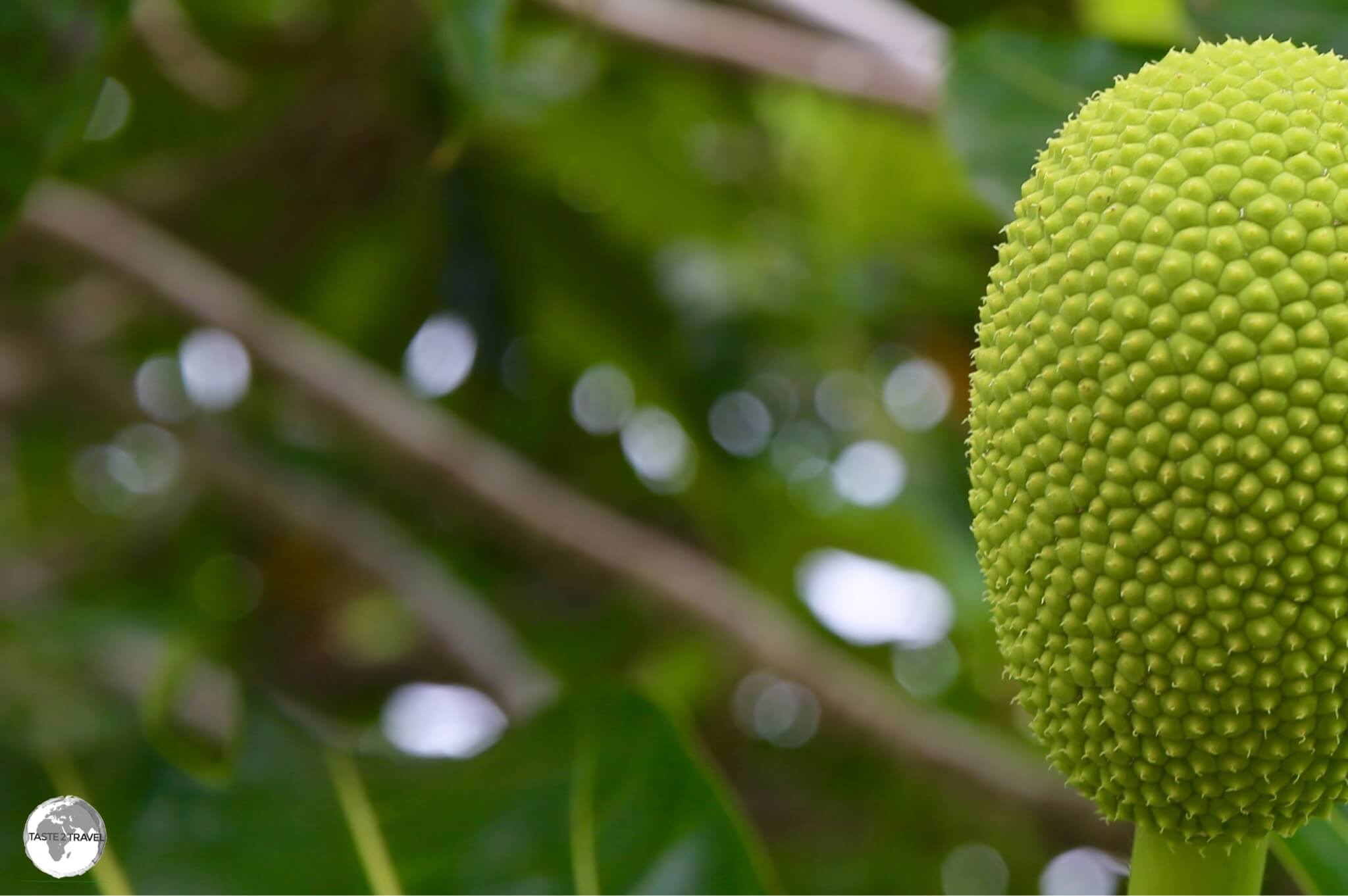
The rich volcanic soil on Tongatapu is ideal for growing different fruits and vegetables, including breadfruit.
The staples of Tongan cuisine is fish, pork, chicken, coconut milk, taro leaves; and various starches such as yams, taro, sweet potatoes, and tapioca.
One of the most popular dishes is spit-roasted succulent pig and one of the best places to sample this is at the Tongan buffet and floor show which is held every Wednesday and Friday evening at the Hina cave, which is part of the ‘Oholei Beach Resort (Tel: +676 – 28864).
Taro

Taro can be seen growing all over Tongatapu.
Taro (from Tahitian) is widely grown on Tonga and is popular for it’s large, starchy, spherical tuber which is cooked as a vegetable, made into puddings and also bread. The large leaves (also known as ‘Elephant’s Ear‘ due to its shape) are commonly stewed.

Taro for sale at Talamahu market in Nuku’alofa.
Visa Requirements

Tongan passport stamps.
Many nationalities are granted a free 31-day Visitors visa upon arrival, while for others a visa is required in advance. You can check your requirements here.
Getting There

On approach to Fua’amotu International Airport with a view of the south coast of Tongatapu.
Air
Tongatapu
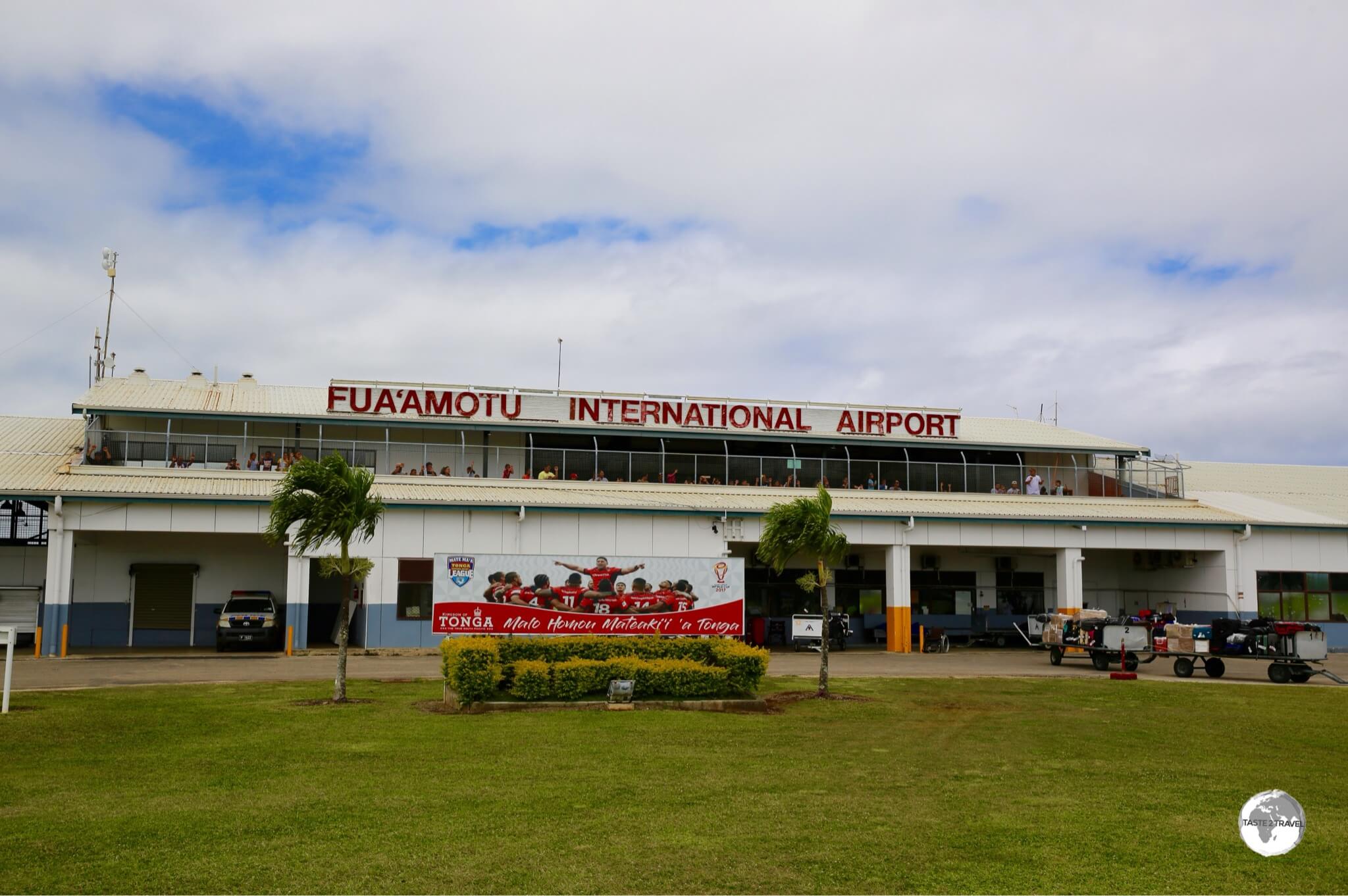
Fua’amotu International Airport – the gateway to Tonga.
International flights into Tonga arrive at Fua’amotu International Airport (named after the nearby village of Fua’amotu), which is located on the main island of Tongatapu, 35 km south-east of Nuku’alofa. Like everything else in Tonga, the airport is closed on Sunday’s and, under Tongan law, can only be opened in distress, after seeking approval from the Transport minister.
The following airlines provide scheduled services to/from Tonga
- Air New Zealand – flies to/from Auckland
- Fiji Airways – flies to/from Nadi
- Qantas – flies to/from Sydney
- Talofa Airways – flies to/from Apia–Faleolo, Pago Pago
There is no public transport to/ from the airport, but hotels can arrange shuttle services (TOP$30) and taxis are available.
Vava’u
Apart from domestic flights offered by Real Tonga, Fiji Airways offer seasonal flights from Suva to Vava’u Island’s Lupepau’u Airport.
Cruise Ship

A cruise ship at Vuna wharf in Nuku’alofa.
About 12 cruise ships visit Tonga each year, docking at the Vuna wharf in downtown Nuku’alofa.
You can view the current cruise schedule here.
Getting Around
Air
Domestic flights were once operated by Real Tonga who ceased operations in 2020.
Taxi
Unmetered taxis can be found on ranks around Nuku’alofa. Its’ best to negotiate the fare in advance, with most trips around town costing TOP$5.
Taxis are often unmarked but can be distinguished by their “T” registration plate.
Bus
Buses are available on Tongatapu, with services operating between 8:00am and 5:00pm Monday to Saturday and to no fixed schedule.
All services depart from the terminals located on the waterfront in Nuku’alofa.
Car Rental

My rental car on Tongatapu Island.
Tourists wishing to drive in Tonga are (officially at least!) required to purchase a ‘Tongan Visitor’s Driver’s License‘ from the Ministry of Infrastructure in Nuku’alofa.

Tongans are very proud and patriotic.
Tongatapu
There are three car rental agents at Fua’amotu International Airport:
- Avis (Tel: +676 21179)
- Star Rental Car (Tel: +677 46630)
- Sunshine Rentals (Tel: +676 781 5780)
These agents have offices downtown and additionally, you can rent cars from some of the hotels. I rented a car from the Waterfront Inn, which offered very competitive rates. All sights on the island can be covered by car in less than a day.

Touring the quiet back roads on Tongatapu.
‘Eua Island
There is no public transport on ‘Eua but two cars are available for hire (always unavailable during my visit) from the Chinese supermarket, which is located next to the Tonga Tourist Authority office in ‘Ohonua.
Even if you did hire a car, signage on the ‘Eua island is non-existent and you’ll never find the spectacular sights which are hidden away in the depths of the rainforest.
The ‘Ovava Tree Lodge offers a half day fully escorted sightseeing tour, which is the best way to explore this amazing island.
Inter-island Ferries

Two different ferries connect Tongatapu to ‘Eua island, the slow car ferry and the faster passenger ferry (seen here at the dock on ‘Eua Island).
‘Eua Island
Ferries from Nuku’alofa to nearby (17.5 km) ‘Eua are operated by the Onemato Ferry Company who run two ferries – the faster, more comfortable MV Maui (1 hour) or the slower, less comfortable car/ freight ferry – the MV Onemato (2.5 hours).

The slow car ferry can get very crowded with the Tongans preferring to lay on their mats on the floor.
During my visit the MV Maui was out of service due to mechanical issues and the schedule of the MV Onemato was frequently changed. The current schedule is posted on the company Facebook page and tickets should be purchased in advance from their office at the ‘Eua ferry wharf.
You can email the company at: eua.seatransport@gmail.com
Ha’apai Island Group
An inter-island ferry operated by Friendly Islands Shipping provides a weekly connection between Nuku’alofa and Pangai (the capital of Ha’apai). The ferry departs Nuku’alofa every Monday evening, arriving 12 hours later in Pangai. The same ferry then continues onto Vava’u.
Returning to Nuku’alofa, the ferry departs from Pangai every Thursday morning arriving in Nuku’alofa 12 hours later. Cabins and meals are available on request. Schedules and fare information is available on their website.
Vava’u Island Group
The same Friendly Islands Shipping ferry continues onto Vava’u from Pangai, reaching Neiafu (capital of Vava’u) 12 hours later.
Returning to Nuku’alofa, the ferry departs every Wednesday evening arriving in Nuku’alofa (via Ha’apai) on Thursday evening.
That’s the end of my Tonga Travel Guide.
Safe Travels!
Darren
Follow me on Instagram:
[instagram-feed feed=1]
Further Reading
Other travel reports from the Pacific region:
Tonga Travel Guide Tonga Travel Guide Tonga Travel Guide Tonga Travel Guide Tonga Travel Guide Tonga Travel Guide Tonga Travel Guide Tonga Travel Guide Tonga Travel Guide Tonga Travel Guide Tonga Travel Guide Tonga Travel Guide Tonga Travel Guide Tonga Travel Guide Tonga Travel Guide Tonga Travel Guide Tonga Travel Guide Tonga Travel Guide Tonga Travel Guide Tonga Travel Guide Tonga Travel Guide
Author: Darren McLean
Darren McLean is an Australian, full-time, digital nomad who has spent 37 years on a slow meander around the globe, visiting all seven continents, 192/ 193 UN countries and 245/ 251 UN+ countries and territories.
He founded taste2travel to pique one’s curiosity and inspire wanderlust.













wow! it’s incredible and beautiful! thank Darren for share this important information
Thanks Caty!
Tonga is an amazing destination – and just across the water from Peru.
Thanks Darren, in Tongatapu at the moment. Enjoyed your photos – what camera did you use?
Hi Heather,
Pleased you enjoyed the photos. I shoot with a Canon EOS 5D Mark III. Hope you enjoyed Tonga.
Darren